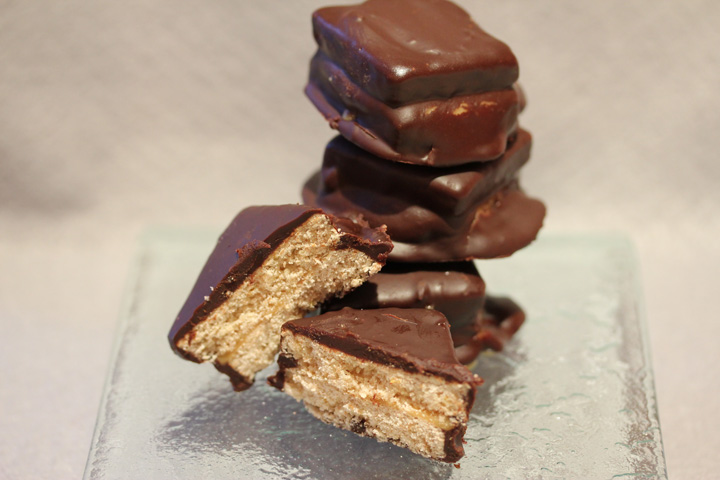That picture above is a cookie of wonder. It has many flavors encased in chocolate. And multiple textures to surprise your tongue and please your brain.
The base for the cookie is a lovely shortbread scented with orange zest. Shortbread cookies are characterized having no egg. This version still has that classic shortbread dry-and-vanilla flavor but now there are orange notes. Yes, when you bake these, you’ll be tempted to just eat the shortbreads. You can do what I did. Bake another batch. Or you can do what I did not: keep your husband at bay.
The two layers of the sandwich cookie surround a middle of dolce de leche. Recently we posted a recipe here for making it yourself at home in your own double boiler. We’ve tested that recipe on many people now and the verdict is unanimous: the best dolce they ever ate. So, I encourage you to try that recipe.
And then after you have made the sandwich cookie, you dip it in chocolate to achieve the ultimate covering. You should refrigerate these cookies and, just out of the fridge, you have a cool chocolate cover that snaps at the bite, the crunchiness of that shortbread cookie, the unexpected taste of orange, and the sweet stickiness of the dolce de leche. It’s all a bit overwhelming, but in a good way.
Brian and I are on the hunt for superior cookies, ones that you can serve as the dessert for a great dinner party. These sandwich cookies are certainly candidates to be cookie stars.
Chocolate Covered Sandwich Cookies with Dulce de Leche
Yield: 45 1 ½-Inch Squares
Ingredients:
- 12 ounces (2 2/3 cups) unbleached all-purpose flour; more for rolling
- 6 ounces (1 1/3 cups) whole-wheat flour
- 2 teaspoons baking powder
- 1 teaspoon salt
- 8 ounces (1 cup) unsalted butter, softened at room temperature
- ¾ cup granulated sugar
- 1 ½ teaspoons grated orange zest
- ½ teaspoon pure vanilla extract
- 26 ounces dulce de leche
- 1 pound bittersweet chocolate, chopped
- 1 pint heavy cream
Preparation:
Make the Cookies:
In a medium bowl, whisk both flours, with the baking powder and salt. With an electric mixer fitted with the paddle attachment, cream the butter and sugar on medium speed until light and fluffy, 2 to 3 minutes. Stir in the orange zest and vanilla. Scrape down the bowl and paddle with a rubber spatula.
With the mixer on low, gradually add the flour mixture to the butter mixture. After adding the last of the flour, but before it is fully incorporated, add ¼ to ⅓ cup cold water and mix just until smooth dough forms, 1 to 2 minutes.
Divide the dough, form into 2 disks, and wrap each in plastic. Chill overnight.
Position a rack in the center of the oven and heat the oven to 350°F. Line 2 cooking sheets with parchment. Roll out the cold dough on a lightly floured surface until it is 1/8 to 3/16 inch thick. With a 1 ½-inch square biscuit cutter, cut the dough into squares. You can use a similar sized round cutter instead. You can gather, reroll, and recut the dough once.
Bake 1 sheet at a time until the edges are very lightly browned and the cookies are very lightly browned and cookies puff up slight, 8 to 10 minutes. Let he cookies cool on a rack and store in an airtight container for up to 3 days or freeze for up to 1 month, until you are ready to fill and coat them.
Fill the Cookies:
Lay out the cookies flat side down. Put a heaping half tablespoon of the dulce de leche on top of half the cookies. Cover each with a top cookie, flat side up.
Coat the Cookies:
Put the chopped chocolate in a small, deep heatproof bowl. In small saucepan over medium-high heat., bring the cream jut to a boil. Pour over the chocolate and let sit for 10 minutes. Stir the mixture very gently, incorporating the cream steadily and without overworking, until glossy and completely mixed.
Line 2 cookie sheets or rimmed baking sheets with parchment. Pick up a sandwich cookie with a small offset spatula. Immerse in the chocolate mixture, flipping the cookie to coat completely. Pick up with the spatula and tap a couple of times on the side of the bowl to get rid of excess chocolate.
With another spatula in the opposite hand, gently smooth out the top of the cookie and then run the spatula along the bottom. Transfer to the parchment-lined sheet. Repeat with the remaining cookies. Allow the coating to set at room temperature for a few hours and then serve.
Store in a plastic continuer, separating each cookie with parchment or waxed paper, in the refrigerator for up to 2 weeks or freeze for up to 3 months.
Source: Cookies Special Holiday Issue 2010 from Fine Cooking

